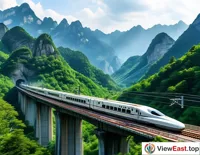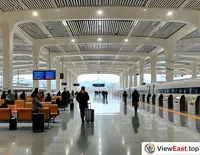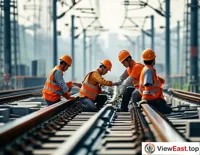






On the vast land of China, silver snakes wind through cities and villages, symbolizing the pride of China's high-speed rail network—China's high-speed trains. This is not just a technological conquest but also an interpretation of speed and passion. This article will take you through the elegance of China's high-speed trains and how they have transformed the face of China and even the world.
The Hatching of a Dream: The Genesis of China's High-Speed Rail
Our story begins in 2008 when China's first high-speed train, the "Harmony" bullet train, sped across the Beijing-Tianjin Intercity Railway, marking China's official entry into the high-speed rail era. At that time, China's high-speed rail was like a newborn baby, tender yet brimming with infinite possibilities. In the following years, China's high-speed rail network expanded at an astonishing pace, with new lines opening and connecting cities across the country like never before.
The Speed Revolution: China's High-Speed Rail Leap
The development of China's high-speed rail represents a revolution in speed. From the initial 250 km/h to 350 km/h, and now up to 400 km/h, China's high-speed trains have continuously broken world records for railway operation speeds. This increase in speed is not just a game of numbers; it means that people can cover longer distances in shorter times, significantly reducing the spatial and temporal distances between cities.
Technological Breakthroughs: Innovations in China's High-Speed Rail
Behind the success of China's high-speed rail lies the hard work of countless engineers and technical teams. They have overcome one technical challenge after another, from lightweight train design to ballastless track technology and intelligent train control systems. Each technological breakthrough has placed China's high-speed rail at the forefront of the world.
Green Travel: China's High-Speed Rail and Environmental Protection
While pursuing speed, China's high-speed rail also embraces environmental protection. High-speed rail has lower carbon emissions compared to planes and cars, making it a truly green mode of travel. The widespread use of high-speed rail has effectively reduced dependence on fossil fuels, contributing to global environmental protection.
Economic Lifelines: The Impact of China's High-Speed Rail
China's high-speed rail is not just a mode of transportation; it is also an economic lifeline. The construction of the high-speed rail network has spurred economic development along its routes, promoting balanced regional economics. Economic circles around high-speed rail stations have gradually formed, with businesses, tourism, real estate, and other industries thriving due to high-speed rail.
Cultural Integration: The Human Touch of China's High-Speed Rail
The convenience of high-speed rail has made cultural exchanges between different regions more frequent. People can easily experience different regional cultures, taste local delicacies, and this cultural integration makes China's high-speed rail not just a transportation line but also a cultural one.
International Cooperation: China's High-Speed Rail Global Vision
The achievements of China's high-speed rail have gained global recognition. China's high-speed rail technology is going global, participating in the construction of high-speed rail networks worldwide. From Asia to Africa and Europe, China's high-speed rail has become a bridge for international cooperation, showcasing China's global vision and responsibility as a major country.
Looking Ahead: The Future of China's High-Speed Rail
Looking to the future, China's high-speed rail will continue to expand its network, with higher speeds, smarter services, and more environmentally friendly technologies on the horizon. China's high-speed rail is not just a mode of transportation; it has become a symbol of China's speed and an indispensable part of China's modernization process.